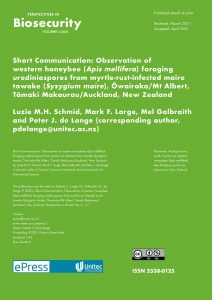Short Communication
Volume 6
Observation of western honeybee (Apis mellifera) foraging urediniospores from myrtle-rust infected maire tawake (Syzygium maire), Ōwairaka/Mt Albert, Tāmaki Makaurau/ Auckland, New Zealand
Luzie M.H. Schmid, Mark F. Large, Mel Galbraith, Peter J. de Lange*
Affiliation:
School of Environmental Animal Sciences, Unitec Institute of Technology, Auckland, New Zealand
* corresponding author: pdelange@unitec.ac.nz
Abstract
Following the detection of myrtle rust disease, caused by the rust fungus Austropuccinia psidii, in New Zealand in May 2017, concerns were raised that western honeybees (Apis mellifera) might forage for and collect Austropuccinia spores. Whilst inspecting cultivated maire tawake (Syzygium maire) trees on the Mt Albert Unitec New Zealand campus infected with myrtle rust, we observed honeybees collecting the urediniospores of this rust. Here we document this observation with images to add further evidence that honeybees present a potentially serious vector in the spread of this rust throughout New Zealand.
Cite as
Schmid, L., Large, M., Galbraith, M., de Lange, P. (2021). Short Communication: Observation of western honeybee (Apis mellifera) foraging urediniospores from myrtle-rust infected maire tawake (Syzygium maire), Ōwairaka/Mt Albert, Tāmaki Makaurau/Auckland, New Zealand, Perspectives in Biosecurity, 6: 1–7.
About the Journal
 Perspectives in Biosecurity is a multi-disciplinary electronic journal of research papers and other outputs covering all aspects of the field of biosecurity including, but not restricted to invasion biology and ecology, invasive species identification/diagnostics, management and eradication/control, new invasive species records, modelling, biosecurity law and policy, relationships between human society and invasive species. This journal has been developed from the paper series of the same name published by ePress since 2015.
Perspectives in Biosecurity is a multi-disciplinary electronic journal of research papers and other outputs covering all aspects of the field of biosecurity including, but not restricted to invasion biology and ecology, invasive species identification/diagnostics, management and eradication/control, new invasive species records, modelling, biosecurity law and policy, relationships between human society and invasive species. This journal has been developed from the paper series of the same name published by ePress since 2015.
- Editors: Dan Blanchon and Mel Galbraith
- ISSN: 2538-0125
- Date of Publication: 01.06.2021